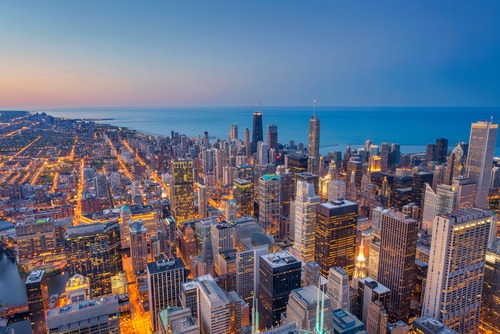
With the first $600-million phase now under way for the five-year, $3.7 billion Chicago Works infrastructure and jobs-creation plan, City Mayor Lori Lightfoot says residents can expect an improved quality of life once the capital plan is completed.
“This effort will allow us to unlock our city’s full potential, give our residents the resources they need to succeed right in their own neighborhoods, and ensure that our city retains its reputation as a world-class destination filled with state-of-the-art infrastructure,” Lightfoot said this week.
The Chicago Works plan was approved by the City Council in November 2020 to make infrastructure investments, put Chicagoans back to work helping the city recover from the ongoing COVID-19 pandemic, and to tackle a decades-long backlog of infrastructure needs.
The City Council last year voted 41-8 to borrow $1.4 billion to fund the first two years of the capital plan, which is expected to total $3.7 billion by 2026. Developed on needs-based condition assessments and data-driven processes conducted by the Chicago Department of Transportation (CDOT) and the city’s Department of Assets and Information Services (AIS), the Chicago Works plan aims to promote public safety, employment and equity via continuing yearly projects to fix aging infrastructure, IT systems and city fleet.
“With paving season underway across our City, we are thrilled to be able to create and offer jobs to our residents that will allow us to make critical infrastructure repairs in all 77 of our neighborhoods,” said Lightfoot during a press conference held at the site of a Chicago arterial resurfacing project at 81st Street and Damen Avenue.
For example, locally hired crews will resurface 75 miles of major city streets, as well as alleys and sidewalks; replace streetlights; modernize traffic signals; and repair and/or replace dozens of bridges and viaducts, according to the mayor’s office, which says the plan specifically calls for repaving 1,240 residential blocks this year, which is roughly 67 percent more than in a typical year.
Lightfoot on Monday joined Aldermen and Chicago officials to officially launch Chicago Works, which she said will rely on the city’s collected data to select and prioritize project investments that address the worst first.
“With an emphasis on equity, the Chicago Works infrastructure plan will allow us to invest in the lives of residents in need and bring our entire city closer together by literally building bridges between our communities,” said the mayor.
In addition to funding the repairs and replacement of traditional infrastructure like roads, bridges, sidewalks, Americans with Disabilities Act (ADA) accessible crosswalk ramps, streetlights, and traffic signals, the Chicago Works plan also will provide funding for projects that the mayor’s office says will help redefine the city. Such projects include nine new streetscape projects in INVEST South/West neighborhoods, as well as funds for public art, planting trees, and implementing Complete Streets.
And such improvements will make it easier for people to safely move around the city “in sustainable ways, like walking, biking, and taking public transit while making our streets and our public way vibrant, safe, and inviting places,” said Gia Biagi, commissioner of CDOT.
“The mayor’s Chicago Works capital plan provides the funding and framework for a legacy investment in our critical transportation infrastructure in neighborhoods across the city, especially in communities challenged by mobility and economic hardships,” Biagi added.
Investments under Chicago Works also will fund improvements that address greenhouse gas emissions, stormwater management and local air quality, said Lightfoot, as well as deferred maintenance for city buildings such as libraries, firehouses and health centers across Chicago, including roofing, heating and cooling ventilation systems, electrical, and plumbing.
Meanwhile, the city’s fleet will receive funds for newer, more efficient public safety vehicles and specialized equipment, according to Lightfoot’s office.
“Revitalizing Chicago’s facilities improves the quality of life in every community by ensuring residents can enjoy city services and programming in buildings that are welcoming and safe,” said AIS Commissioner David Reynolds. “Additional investments in fleet and equipment will not only drive down our operations and maintenance costs but improve the efficiency and productivity of our workforce ensuring residents get services faster.”
Chicago’s procurement and contracting process related to the new plan also will prioritize using minority, women-owned and locally owned businesses, the mayor’s office said.
“Finding employment in the construction trades represents for many the chance for a career, with potential for advancement and family-sustaining wages and benefits,” said Karin Norington-Reaves, CEO of the Chicago Cook Workforce Partnership. “We are working with the city to provide a solid pipeline of qualified men and women for the opportunities being created by this capital investment.”